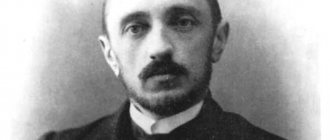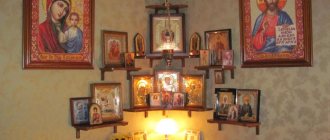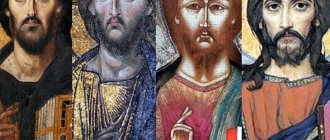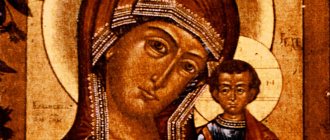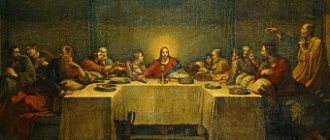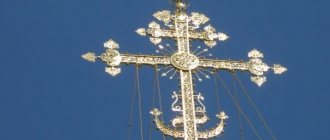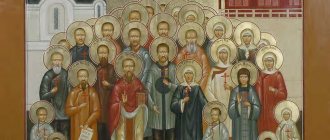In churches and monasteries, in the homes of Orthodox believers, and in other places, people are faced with an amazing event: the icon has become myrrhized! What it is? How to understand such a phenomenon? Is it from God or from the Devil? Let's try to figure it out.
It’s worth starting with what the myrrh-streaming of icons is. What is this phenomenon? We are talking about when liquid appears on shrines. It can be of different colors, types and consistency.
The amount of outgoing liquid also varies. In some images small drops appear, in others the liquid flows in a stream.
As a rule, the liquid is fragrant, like the sacred myrrh. There are different smells. Sometimes the smell of certain flowers is clearly felt, sometimes it smells like caramel, in some cases you can smell incense. However, all the smells emitted by the icons are quite pleasant. It happens that there is no smell from the liquid.
Often the smell from shrines is similar to the fragrance of the world used during the sacrament of anointing. However, it is worth distinguishing the sacred myrrh from the liquid during myrrh flow. Myrrh, used in Orthodox churches, consists of vegetable oils, fragrant resins and fragrant herbs. The number of ingredients often reaches 50 units.
The composition of the liquid emanating from the shrine is different from the world. Therefore, the name “myrrh-streaming” is conditional.
The concept of holy chrism
Holy myrrh is called oil or oil prepared and consecrated in the church according to a special rite. The sacrament is performed by the patriarch once every three years. After consecration, the oil is bottled and distributed to churches. Parishioners are anointed with myrrh, new churches are consecrated.
Oil is olive oil mixed with white grape wine. In addition to the oil, the holy world contains 40 aromatic oils. There is no strict recipe for making a world. The main ingredients are incense, rose petals, violet and galangal roots, rose oil, cloves, nutmeg, and lemon. For unknown reasons, icons and relics of saints exude holy myrrh. Fragrant oil covered the remains of Nicholas the Wonderworker, John the Theologian, and Demetrius of Thessalonica. The fragrant liquid was drained in large quantities from the relics of Theodora of Thessalonica. Holy myrrh heals diseases. Even Muslims collect it from Christian shrines.
Myrrh-streaming of past centuries
The mystery of “crying” shrines has occupied the minds of Orthodox Christians since the early Christian period. As already mentioned, the flow of myrrh was described in Holy Scripture. It was also mentioned in the apocrypha, unrecognized by the church.
The miracle was first reported by the Byzantine chronicler John Skylitzes, who dates the miraculous phenomenon to 1040. After Epiphany, Rus' also learned about myrrh-streaming icons. One of the records comes from the pen of Dmitry Rostov, a bishop of the Russian Orthodox Church, which confirms that “crying” images were already encountered in the 7th century.
The miracle was first reported by the Byzantine chronicler John Skylitzes
Church opinion
The clergy have ambivalent attitudes towards the flow of myrrh. According to Christian doctrine, icons are associated with the prototypes imprinted on them. The spiritual message embedded in the prayer passes through the icons to the patron saint, the Mother of God or the Savior. Myrrh streaming is a message from the other side, a sign of the Kingdom of God. But what exactly the drops of oil on the face portend is difficult to guess.
Cases of icons streaming with myrrh are investigated by a commission from the diocese to rule out fraud. Chemical analysis revealed that the composition of the world from the icons contained sunflower oil, as well as a substance from the resin of deciduous trees growing in Arabia. The clergy do not allow more thorough scientific research of the shrines. Laboratory tests will not help to understand where myrrh comes from. A technique for measuring miracles has not yet been invented.
The facts of falsification are recognized in the church environment. The priests resort to a ruse to attract believers to the temple and collect large donations. Participants in commissions investigating cases of myrrh streaming noticed a pattern: only icons of private owners and new images cry. The chief expert of the group for the study of miracles of the Russian Orthodox Church, P. Florensky, expressed a philosophical interpretation of the phenomenon: one should not exaggerate the importance of myrrh flow. The real or staged phenomenon is performed for the glory of God. Professor Florensky also notes that the famous ancient Russian shrines did not stream myrrh.
According to modern theologians, the appearance of tearful, bloody, oily liquid does not mean the unconditional holiness of the object. Pagan idols were covered with oil. The icons of the “Virgin Center”, a new Moscow sect, are actively shedding tears. The phenomenon is often used for personal gain. Each case must be verified so as not to mislead believers.
In most cases, myrrh streaming is declared a miracle. But the evil one can disguise himself as divine miracles and awaken vanity in priests and owners of unusual images.
Is there a scientific explanation
There is no exact scientific explanation for the phenomenon. Scientists point to possible natural causes of myrrh streaming:
- involuntary application of oil to the surface of shrines - during a kiss after the ritual of anointing;
- condensation - the oil evaporates under the influence of heat from burning candles, drops of liquid from the air settle on the icons;
- capillary effect - the movement of liquid through narrow channels of porous materials.
The cause may be chemical changes in paint and varnish, and room conditions. The Commission for the Description of Miracles recorded cases when clean brought icons were oiled in a house with myrrh-streaming images. Science also does not rule out fraud.
Versions of skeptics
Many skeptics believe that there are understandable reasons why the icon streams myrrh. What does this mean in their opinion? Skeptical people claim that the liquid exuded by the images is:
- Wood resin.
- Condensate.
There is probably some truth in the words of skeptics, and the appearance of liquid is not always due to unexplained reasons. But how can one explain the myrrh-streaming of frescoes, metal images, lithographs and even paper photocopies?
Popular hypotheses
In Ancient Rus', icons still cried, but rarely. The first mention of the phenomenon appeared in the time period from the 11th to the 18th centuries. Then in St. Petersburg there was a myrrh-streaming session with exposure, in which Peter the Great participated. In 1917, revolutionaries devalued the shrines. They were hidden in nature reserves and museums.
With the advent of the 90s, the image began to get annoying. The joy of a home miracle was shared in the media and then on the Internet. Isolated cases of myrrh streaming caused surprise and a surge of faith. People were drawn to the church, which gave hope for the best. The icons began to stream myrrh more often. The new millennium marked an unprecedented miracle - reproduction began to cry.
An incredible incident required an explanation of the phenomenon as a whole. According to the first hypothesis, oil gets onto the images mechanically.
Ways they are made to cry:
- The board is dipped in oil, dried, an image is written on it, and pierced with a thin needle. In a warm room, the oil comes to the surface in the form of tears;
- the lamp wick sprays oil;
- thick oil is placed behind the icon inside the frame; it melts and flows out from the front side through the holes.
P. Florensky, during his work on the commission for describing miracles, came to the conclusion that icons do not stream myrrh. Oil settles on their surface.
Another hypothesis was put forward by Belarusian scientists. According to their assumption, myrrh streaming is caused by fungi. Experts from the organization for the study of anomalous phenomena "UfoCom" analyzed the myrrh-streaming image under a microscope and discovered fungal hyphae. But it was not possible to establish its type.
The third version is poltergeist. Paranormal phenomena researchers at UfoKoma note that myrrh-streaming, like poltergeists, occurs in the homes of people with mental disabilities and severe physical illnesses. A resident of the village of Klin-9 suffered from cerebral arachnoiditis, accompanied by epileptic seizures. For a resident of Vitebsk, the image became tranquil during an exacerbation of lung cancer. Other owners suffered from liver cirrhosis and asthma.
What both phenomena have in common is that they appear in a specific place in the presence of a specific person. The images stream myrrh in front of their owners. The owners accompany the shrines after announcing their miraculous nature. All hypotheses are based on assumptions and subjective conclusions. Some cases do not fit into any of them.
The most famous myrrh-streaming icons in Russia and the world
The Moscow Church of the Archangel Michael collected the most myrrh-streaming icons. The most famous are the image of “All Saints”, “Seven Arrows” and “Iveron Icon of the Mother of God”. In the Church of St. Nicholas in Pyzhi, the image of his patron and the icon of Tsar Nicholas II wept. In the Church of the Life-Giving Trinity, the patroness of Count Rezanov, the “Kazan Icon of the Mother of God,” streamed myrrh.
The icon printed at the Sofrino printing house became famous throughout the world. The icon “Softening Evil Hearts” began to bleed myrrh after being applied to the relics of Saint Matrona. At first, pilgrims gathered in the owners’ apartment, and then the icon was transported to a church near Moscow. Drops of oil appeared before the sinking of the Kursk submarine, the terrorist attack on the Nord-Ost musical and the tragedy in Beslan. Based on the name of the printing house, the icon was nicknamed “Sofrinskaya” and was ranked among the miraculous. They made a religious flight with her in a helicopter around Volgograd after the New Year's terrorist attacks in 2013.
The “Sofrinskaya” icon was taken to Australia, Germany, the USA and Canada to meet with Christians. Later, believers told about the miracles of healing to the custodian of the icon, Father Sergei Fomin. In 2022, the icon celebrates its anniversary - 20 years of myrrh-streaming. The most famous foreign shrine is the “Iveron Icon of the Mother of God” from the temple in Montreal. The image exuded myrrh for 15 years, but after 1997 the myrrh flow stopped. The icon's successor is located in Hawaii.
Notes
- It should be distinguished from the world, which is brewed in every local Orthodox Church and is used to perform the sacrament of confirmation.
- Grishechkina N.V. Renewal and myrrh-streaming of icons (chapter from the book “Miraculous Icons in Rus'”)
- Florensky P.V., Moskovsky A.V., Soshinsky S.A., Shutova T.A. Test by miracle? // Miracles, true and false. M. 2008. pp. 11-36 ISBN 978-5-89101-269-1
- ↑ 123
Pavel Florensky: “Myrrh-streaming icons “work” like nuclear power plants” - About the myrrh-streaming of holy relics
- The Suffering and Miracles of the Holy Glorious Great Martyr Demetrius
- Charalambos Bakirtzis Pilgrimage to Thessalonike: The Tomb of St.
Demetrios // Dumbarton Oaks Papers, Vol. 56. (2002), p 176. - Official website of the Basilica of St. Nicholas (English) (inaccessible link). Access date: January 17, 2010. Archived September 22, 2013. (English)
- ZOSIMA'S WALK TO TSARGRAD, ATHOS AND PALESTINE (The journey and events of the sinful monk Zosima, deacon of the Sergius Monastery.) 1419-1422 // Book of Walks. Notes of Russian travelers of the XI-XV centuries. - Moscow: Soviet Russia, 1984. - P. 305. - 448 p.
- During a service in Sevastopol, the icon was filled with blood.
- Lyubomudrov A. A.
Myrrh-streaming and crying of icons. - Myrrh-streaming: why do icons cry?
- Dyachenko G., priest.
Complete Church Slavonic dictionary. - M., 1900. - P. 325. - Bakirtzis C.
Pilgrimage to Thessalonike: The Tomb of St. Demetrios // Dumbarton Oaks Papers. - Vol. 56. - 2002. - P. 187. - Deacon Andrey Kuraev
. Church in the world of people. Archived copy from February 1, 2009 on the Wayback Machine - About the authorities and the Church of Christ (interview with Metropolitan Nikolai (Kutepov))
- The order is given according to V. Sokolov, deacon.
About the flow of myrrh, real and imaginary. - Boris Balashov, archpriest.
On the churchliness of miracles // Moscow Diocesan Gazette. - 2005. - No. 3-4. - Acts of Peter the Great, the wise transformer of Russia; collected from reliable sources and arranged by year. M., 1789. Part VII. pp. 93-97.
- Basov D. The miracle of myrrh flow. St. Petersburg, 2001. ISBN 5-88801-240-8. P. 40
- Quoted from Duluman E.K. Myrrhflow - Nonsense on vegetable oil
- Anomaly No. 16 (148), September 1, 1997 (based on materials from the Skeptical Inquirer magazine, No. 2, 1997) (Russian) (inaccessible link). Access date: February 1, 2009. Archived October 10, 2006.
- Sanal Edamaruku under threat after Catholic 'miracle' revealed
Can a home icon stream myrrh?
The phenomenon occurs more often with domestic images. In Soviet times, they also cried. The phenomenon was not reported in the media. Since the late 80s of the 20th century, the phenomenon has become widespread.
Features of home myrrh-streaming:
- often meets;
- associated with a place or image;
- switches to the brought images.
The facts of myrrh-streaming of paper reproductions and even photocopies also confirm the connection of the phenomenon with the home. Neighboring household items are sometimes also coated with oil.
Interesting Facts
Cases of explainable and inexplicable myrrh streaming:
- Toronto, Canada. A representative of the Society of Skeptics, Joe Nickell, went to one of the Orthodox churches to examine the myrrh-streaming icon. The expert examined the location of the shrine and surrounding objects. His conclusion disappointed the priests. Oil appeared from a lamp hanging nearby;
- Mumbai, India. Pilgrims flocked to the statue of Jesus Christ to venerate the Savior’s feet, which flowed with holy water. The phenomenon attracted the interest of a local TV channel. The skeptic Sanal Edamaruku was invited to investigate. The results shocked believers and clergy. The moisture turned out to be sewage. A sewer burst in a nearby laundry room. The liquid reached the statue through capillary action;
- Bryansk region, Russia. The commission visited the house of the owner of the myrrh-streaming icons. Scientists did not see the formation of droplets in the images. The icons lay on the table, on white paper. The invited priest served a prayer service in the room. Then the hostess asked everyone to leave so as not to desecrate the sacrament. An hour later, the scientists entered the room and saw oil on the surface of the images and on the edge of the paper sheet. Under the icons the paper remained clean. In one image the moisture has been wiped away. No fresh drops appeared. Conclusion - the drops settled on top;
- Minsk, Belarus. Lawyer V. Erchak ordered the icon painter to create the wedding icon of the Mother of God “Sovereign”. Two years later he went to Jerusalem and consecrated the image at the Holy Sepulcher. One day a lawyer was praying in the morning and saw drops in the image. The fragrant myrrh flow intensified over several days. The image was shown in churches until the lawyer donated it to the House of Mercy. Soon a miracle of healing happened. The girl overcame skin cancer after praying in front of the image;
- Cherikov, Belarus. A large fragrant drop appeared on the “Kazan Mother of God” in a wooden frame. The Weeping Icon was in the Church of the Nativity of the Virgin Mary. It was given to the parish by a local resident;
- Ivanovo, Russia. More than 13 thousand icons were consecrated in the convent. The phenomenon began on the day of St. Andrew the First-Called in the cell of two nuns, and then covered the entire monastery. The fragrant liquid appeared on the brought images, even illustrations in Orthodox books. In 5 years, the nuns collected 4 kilograms of peace. Journalists brought an ancient icon of St. Nicholas the Wonderworker to the monastery as an experiment, but no drops appeared on it.
Professor Florensky witnessed an amazing incident in one of the Russian churches. Inside, the word “Love” appeared on the wall at night. It was written in blood, and so high that a person could not climb there. Gradually the inscription faded. In its place the word “God” appeared. Then all the icons in the church began to cry. Myrrh streaming was observed by priests and scientific skeptics. Their experience has shown that in two cases out of three the phenomenon turns out to be a hoax. In other episodes there is a feeling of understatement.
A logical explanation for the phenomenon can only be found in theory. There is no direct evidence of the existence of a natural mechanism or divine providence. In any case, the flow of myrrh is a test of faith. A true believer cares about the salvation of the immaterial soul and does not require material evidence of his existence from God. But in worldly worries you need a breath of fresh air, and such inexplicable miracles provide it.
The secret of exposure
On the one hand, such a sign always carries a bit of uncertainty: no one knows what this phenomenon portends - good or evil, and what one should prepare for. On the other hand, even deeply religious people sometimes doubt the authenticity of such a phenomenon. This is because history knows many cases when clergymen tried to deceive the people and the authorities in this way in order to achieve certain goals.
Thus, under Peter I, the clergy of one of the churches stated that in their cathedral a phenomenon of myrrh-streaming of icons occurred. The revelation was not long in coming. Despite the fact that the king was a believer, he still doubted the authenticity of what was happening. The priests unanimously declared that in this way God mourns the old order, which was abolished by the Great Tsar. Peter I dared to assume that, using this event, the priests wanted to persuade him to cancel the innovations and return to the old order.
He was quite skeptical about such a “divine” manifestation and ordered the myrrh-streaming image to be taken away from the cathedral. After arriving at his palace, the king destroyed the icon and discovered capsules with liquid located inside it in the eye area. In turn, small holes were made in the eyes through which the liquid came out.
In this regard, the tsar issued a formidable decree, which read: “If the icons in any church cry, then the priest’s asses will cry with blood . Since then, the images no longer “cryed.”

